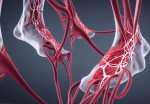Transcatheter edge-to-edge repair (TEER) with MitraClip has demonstrated its benefit compared with complete guideline-directed medical therapy (GDMT), according to the results of the COAPT Study. While cerebrovascular events (CVE), such as stroke or transient ischemic attack (TIA), are rare, they can occur during the procedure (transseptal puncture, device positioning, or device release) or during follow-up...
Transcatheter Mitral Valve Replacement vs. Medical Therapy
Mitral valve regurgitation (MR) is a common cause behind heart failure and is associated to hospitalization for heart failure and higher mortality. Transcatheter edge-to-edge repair (TEER), together with guideline-directed medical therapy (GDMT) has been shown beneficial in high risk patients, according to the COAPT study. However, there is a significant group of patients that make...
Aortic Stenosis and Cardiogenic Shock: Is TAVR an Option?
Cardiogenic shock (CS) in a setting of aortic stenosis is associated with high mortality rates. In consequence, surgery is generally not a possibility for this patient group, and they usually undergo aortic valvuloplasty, resulting in a mortality rate of 33%-50% at 30 days, 70% at one year, and 90% at two years. While transcatheter aortic...
We Should Revascularize Patients with Stable Coronary Syndromes and Ischemia Assessed by iFR
Chronic stable angina has shown a good response to medical treatment, and the Ischemia study has recently demonstrated the safety of such treatment in stable chronic angina with moderate to severe ischemia. However, this study excluded left main coronary artery (LMCA) lesions. The FAME Study has shown the safety and efficacy of fractional flow reserve...
COAPT: Nutritional Condition Is an Important Factor in Edge-to-Edge Treatment
Heart failure is strongly associated with malnutrition or poor nutrition, which has been linked to increased mortality during follow-up. We know that mitral regurgitation causes progressive heart failure and affects nutrition. The COAPT Study has demonstrated the benefits of edge-to-edge treatment in mitral regurgitation when combined with comprehensive medical treatment and maximum tolerated doses. However,...
VASC-OBSERVANT II Substudy: Impact of Vascular Complications after TAVR
At present, transcatheter aortic valve replacement (TAVR) has become increasingly common to treat severe symptomatic aortic stenosis, with the transfemoral approach being the most common access strategy, associated to better outcomes vs. other access sites. Even though vascular complication rates (VC) have dropped given increased operation experience and improved devices, such as the use of...
Calcified Nodules and the Importance of OCT Categorization prior PCI
TLR associated factors in patients with calcified nodules. Patients with complex cardiomyopathies undergoing percutaneous coronary intervention are increasingly common, as is the case for calcified lesions and calcified nodules (CN). Procedure complexity not only involves planning, but also establishing patient prognosis, taking into consideration the fact that most target vessel events occur at long term...
BASIL-2: Revascularization of Infra-Popliteal Territory in Patients with Critical Lower Limb Ischemia
Results of infrapopliteal territory revascularization in critical limb ischemia. Compared against the general population, patients suffering from critical lower limb ischemia (CLI) not only experience seriously limited quality of life, but also face a significant higher risk of death and amputation. Specifically, the optimal treatment for these patients remains uncertain. This uncertainty was sparked by...
5 Year Evolution of PCI vs CABG in Large Randomized Studies on Acute and Chronic Coronary Syndrome
Left main lesions in acute coronary syndrome (ACS) represent a major risk and, at present, the best revascularization strategy is a matter of debate. Though many studies and registries have excluded this group of patients, there is data on the pros and cons of both percutaneous coronary intervention (PCI) and cardiac artery bypass graft (CABG). ...
Minimal Stent Area: New IVUS Parameter?
Intravascular Ultrasound (IVUS) has shown, in several studies, its great benefits for both restenosis and mortality reduction. Even though several variables have been studied, so far minimal stent area (MSA) has been disregarded as important. The OPTIVUS-Complex PCI looked at 961 patients with 1,957 lesions, and found 1.6% TLR incidence (30 lesions). There were no...









